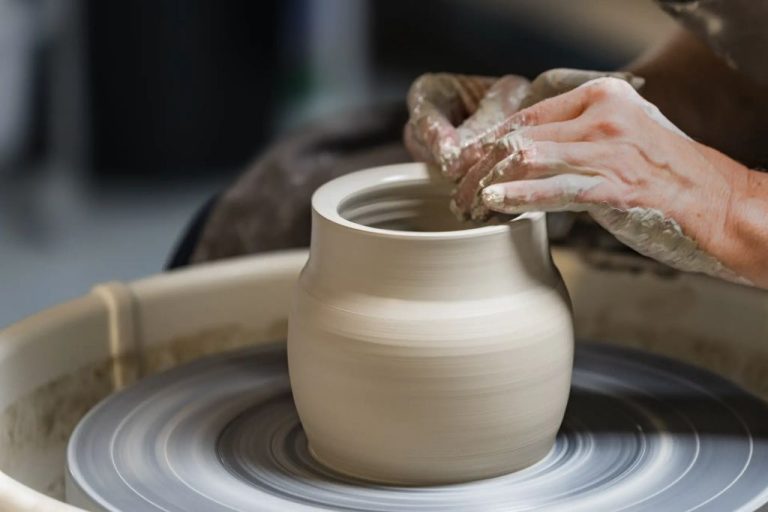Can You Use Clay To Build A House?
Clay is a naturally occurring material composed primarily of fine-grained minerals like silica and alumina. It has been used as a building material for thousands of years due to its abundance, moldability when wet, and durability when dried into bricks or blocks. The key properties that make clay suitable for construction include:
- Plasticity – Clay can be molded when wet into various shapes, then hardens when dried.
- Strength – Clay has good compressive strength when compacted and dried.
- Thermal properties – Clay has high heat capacity and low conductivity, creating natural insulation.
- Impermeability – Clay repels water penetration when properly compressed.
- Availability – Clay deposits are found worldwide, providing accessible local building materials.
With these characteristics, clay has remained an attractive natural building material for millennia. This article explores using clay as the primary structural element for modern home construction.
Clay Construction Methods
There are several different methods used for constructing homes out of clay. Three of the most common are adobe, cob, and rammed earth.
Adobe involves making bricks from clay soil mixed with sand, water, and sometimes other materials like straw. The adobe bricks are then used to build walls, which can be load-bearing or infill between post and beam frames. Adobe bricks can be stabilized with cement or asphalt emulsion for added strength and water resistance.
Cob is an ancient method of building walls using lumps of clay, sand, straw, and water. The cob mixture is applied layer by layer to build up the wall, then sculpted and shaped by hand. Cob requires protective roof overhangs and appropriate foundations to avoid water damage.
Rammed earth involves compacting moistened subsoil between forms to create dense walls. A rammed earth mixture typically contains clay, sand, and gravel. Forms are removed after compaction and walls are then finished. Rammed earth provides thermal mass for energy efficiency.
Benefits of Clay Homes
Building with clay offers a number of benefits that make it an attractive option for eco-friendly home construction. Clay is a natural and sustainable material that is renewable and widely available. Clay homes are energy efficient due to the thermal mass properties of clay which helps moderate interior temperatures. The thick clay walls provide superior insulation from the elements. Clay is also an affordable construction material that is much cheaper than many conventional building materials. Here are some of the main benefits of building a home with clay:
- Natural and sustainable – Clay is an abundant natural material that is renewable and eco-friendly to source and use in construction.
- Energy efficient – The high thermal mass of thick clay walls and floors helps regulate interior temperatures and reduces the need for heating and cooling.
- Superior insulation – Clay has excellent insulation properties that keep interiors comfortable in both warm and cool climates.
- Affordable – Clay is an inexpensive construction material, reducing the overall cost of building a home.
- Renewable and recyclable – Clay can be re-used and homes can be modified and expanded using the same clay building techniques.
- Healthy indoor environment – Clay naturally moderates humidity levels and does not emit harmful VOCs.
With its natural sustainability, energy efficiency, superior insulation, affordability, and healthy indoor environment, clay offers many advantages as a green home building material.
Challenges of Clay Homes
While clay construction offers advantages, clay homes also come with some unique challenges that need to be considered.
One of the main difficulties with clay construction is that earthen walls can be susceptible to weather damage and erosion. Prolonged exposure to heavy rain can cause walls to weaken, crack, or even collapse if not properly stabilized or protected. Regular sealing and maintenance is crucial.
Clay homes are also quite heavy, given the dense nature of compacted earth. This restricts design possibilities, as large open spans or tall walls become impractical. Homes need to be designed with the structural capabilities of clay in mind.
The thickness required for stabilized earthen walls also reduces potential interior space in a clay house. Walls need to be 12 to 24 inches thick, potentially consuming interior square footage.
Clay construction is also very labor and skill intensive. It requires learning specialized techniques for successful wall building and finishing. This can make DIY clay home projects more difficult.
These challenges help explain why modern clay construction is less common, despite its eco-friendly and sustainable attributes. With proper design, maintenance, and protection though, clay remains a viable home building material.
Clay Home Design Considerations
The structural design of a clay home requires careful planning and engineering to ensure stability. Clay walls cannot support too much weight, so the roof design needs to be lightweight yet durable. Some common roofing options for clay homes include thatch, clay tiles, or corrugated metal sheets.
The foundation is crucial for stabilizing a clay home. The floor can be built with clay, but it needs extra reinforcement. A stone foundation helps prevent shifting and cracking from ground moisture. Termite barriers should also be included in the foundation design.
It’s important to include roof overhangs and drainage components to protect clay walls from water damage. The structural frame needs tie beams at corners and openings to handle seismic and wind forces. Wood lintels can reinforce windows and doors.
Clay thickness should be at least 12 inches for exterior walls, with thicker areas on upper floors. Interior clay walls can be thinner but still need plaster and limewash coatings to protect the surface.
A clay home requires ongoing maintenance to ensure structural integrity over time. Proper clay composition, building techniques, moisture control, and foundation design are all critical considerations.
Clay Home Maintenance
Proper maintenance is crucial for clay homes to ensure their longevity and protect them from water damage. Here are some key maintenance considerations:
Plastering
The clay plaster on walls and ceilings should be inspected regularly for any cracks or damage. Small hairline cracks are normal, but larger cracks can let in moisture and should be repaired. Re-plastering walls every 5-10 years helps protect the clay and maintain a nice appearance.
Drainage
It’s critical to prevent moisture buildup around clay homes. Ensure proper drainage away from the structure and avoid landscaping that holds water against walls. Install gutters, downspouts, and splash blocks to redirect roof runoff. Use sloping bases or stem walls under adobe homes to prevent flooding.
Sealing
Applying natural sealants like limewash or linseed oil to exterior walls every 2-3 years helps repel water. Sealants penetrate the clay to make it more water resistant. Interior clay walls and floors can be sealed as needed to protect them from moisture damage. Properly sealing a clay home is key to its longevity.
Clay Home Costs
The cost of building a clay home can vary greatly depending on the size of the home, construction methods, and local labor rates. However, in general, clay homes tend to be more affordable to build than conventional stick-frame construction.
The raw clay materials themselves are typically very inexpensive or even free if extracted on-site. However, specialized labor is required for tasks like sculpting, cob building, rammed earth construction, etc. This skilled labor can add cost, with estimates ranging from $15-30 per hour or more.
Other material costs include items like clay stabilizers (cement, lime, bitumen, etc.), reinforcing bars for compressed earth blocks, forms for rammed earth, sand, straw, specialized tools, and clay extraction equipment if needed. Overall, the material costs are estimated to be 15-30% lower than conventional building.
The labor-intensive nature of clay construction can offset some of the material savings. However, with experienced crews, clay homes can be erected quickly. Typical estimates range from $100-200 per sq ft for simpler methods like adobe, up to $300+ per sq ft for more sculpted designs.
In the end, the cost savings of clay homes are maximized when self-built, using on-site materials, and keeping to simple designs. With thoughtful planning, clay offers a very affordable natural building option.
Clay Home Examples
For thousands of years, humans have built shelters from clay due to its availability, low cost, and natural insulating abilities. Two of the most common techniques for building clay homes today are cob and adobe.
Cob homes are made by shaping lumps of clay mixed with sand, straw and water into monolithic walls. The cob mixture is applied by hand in layers to form the walls, which are then covered in plaster to protect them from the elements. Cob homes have an organic, curving shape and thick earthen walls that provide natural temperature regulation. Famous examples of cob homes can be found in the Pacific Northwest and British Columbia.
Adobe homes are built using sun-dried bricks made of clay, sand and straw. The adobe bricks are stacked like regular bricks and held together with adobe mud mortar. Adobe bricks can be formed into straight walls or curved structures. Adobe homes are known for their thermal mass, which helps keep interiors comfortable year-round. The American Southwest is filled with historic adobe homes and buildings.
Both cob and adobe styles allow ample design flexibility while taking advantage of the sustainability, durability, and energy efficiency of earthen construction. With proper maintenance, clay homes can last for generations.
Clay Home Building Codes
When constructing a clay home, it’s important to be aware of relevant building codes and regulations in your area. These exist to ensure homes are structurally sound and safe to inhabit.
Building codes for earthen homes vary significantly depending on location. Some jurisdictions have extensive regulations surrounding clay construction, while others lack clear guidelines. It’s essential to research local building codes before beginning your clay home project.
In many areas, you’ll need to obtain permits for clay home construction. The permit process helps ensure your design and techniques meet code requirements. Your local building department can provide specifics on permit needs in your region. They’ll also conduct inspections at various stages of construction.
Building codes primarily focus on structural integrity and safety. Load-bearing clay walls must be thick and strong enough to support ceilings, upper floors, and roofing. Openings like doors and windows can require reinforced framing. Electrical, plumbing, and other systems need proper installation and protection.
Fire resistance is another common concern. Most codes require non-combustible finishes on interior and exterior walls. Some jurisdictions limit clay construction based on occupancy type, like apartments or public buildings. Engineering assessments may be needed for unusual designs.
While clay can require more planning and approvals, many building departments recognize its sustainability benefits. If your area lacks earthen home codes, proactive communication with officials is wise. There are often ways to comply with small modifications.
Conclusion
Clay remains a viable building material for modern home construction despite some limitations. With proper design and maintenance, clay homes can be beautiful, sustainable, and affordable. Clay’s natural insulating properties, abundance, and low environmental impact make it an attractive eco-friendly building material. While clay construction may not be suitable for all homeowners, its longevity and aesthetic appeal ensure that it will continue to be used around the world.
With careful planning and execution, building a clay house is possible and can result in a high quality, unique home. However, clay construction requires expertise to address structural stability, weatherproofing, and Humidity control. Homeowners considering clay construction should research building codes thoroughly, hire experienced contractors, and be prepared for higher maintenance needs. Overall, clay offers significant benefits but also requires consideration of its drawbacks.


